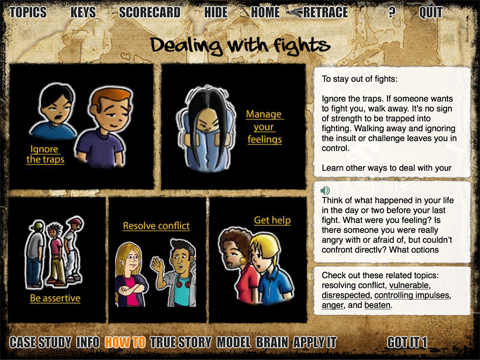
Ripple Effects for Teens - School Edition app for iPhone and iPad
Developer: Ripple Effects
First release : 18 Sep 2015
App size: 2.33 Gb
Do you have Ripple Effects for Teens in your school? This iPad version is an extension of the award-winning program that your school has licensed. There is no additional fee to extend your school license to this new platform.
Ripple Effects for Teens is a learner directed tool to solve personal problems – very serious ones, and everyday ones. It provides personalized guidance in more than 400 areas that affect student behavior, motivation, learning and connectedness, and protects students’ privacy at every step along the way. Students build cognitive, behavioral and affective skills linked to higher scores on resiliency assets, better behavior and higher grades. From defiance and disruption to truancy, vandalism, sexual harassment, bullying and hundreds more, Ripple Effects for Teens addresses both the surface concerns and the reasons underneath them to strengthen every student.
It makes teachers’ lives easier:
This reading-independent tool allows students to receive motivational counseling and direct behavioral supports as they build social-emotional competencies – without taking instructional time away from the rest of the class. Peer modeling, true stories, media analysis, journaling, interactive self-profiles and games to assess mastery provide built-in, differentiated instruction.
A supplementary set of web-based tools makes it easy to track individual and group student progress.
It uses expert system technology:
Ripple Effects’ Whole Spectrum Learning Platform uses learners’ natural selection patterns to deliver the most relevant set of evidence-based practices for whatever concerns them. A huge library of content and engaging multimedia activities offers a system of integrated resources for culturally competent, truly personalized, tiered interventions to address non-academic factors in school and life success.
It works:
Ripple Effects for Teens is listed on the National Registry of Evidence-Based Programs and Practices (NREPP), sponsored by NIH as a comprehensive children’s mental health and substance abuse intervention. It has been shown to increase resiliency assets, decrease suspensions, absenteeism and behavioral referrals for Black, Latino and Caucasian students from traditional, alternative, charter and continuation schools in rural and urban settings. It has also been shown to boost GPA scores, especially among students most at risk of school failure. GPA is the single factor most correlated with going to college.



